Contents
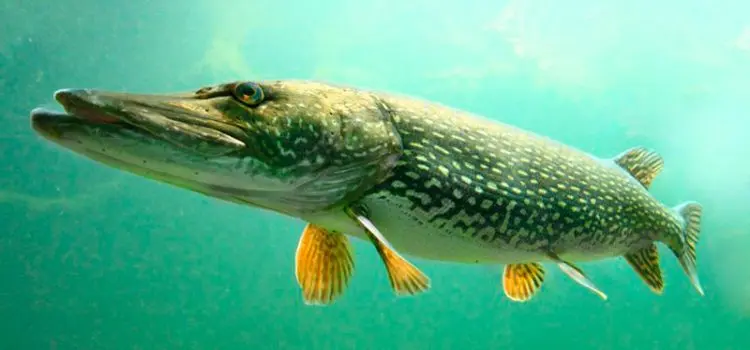
Pike is a predatory fish that represents the Pike family, the class of ray-finned fish and the Pike-like order. This predator is found in almost all medium and large reservoirs, although it is also found in small rivers, ponds and lakes. At the same time, the pike inhabits fresh water bodies all over the planet, on the territory of many countries of the world.
Pike: description
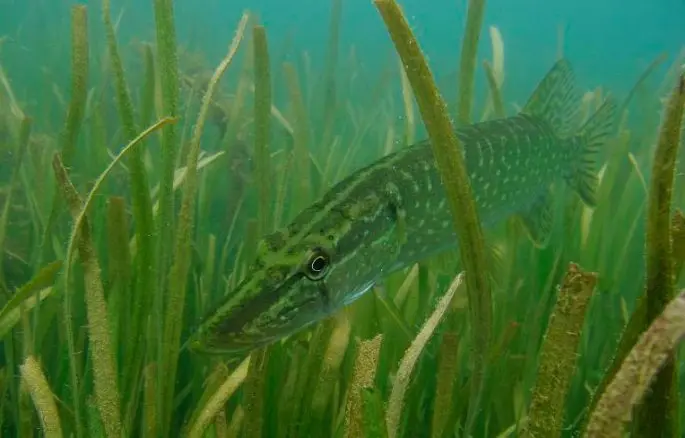
Pike feel comfortable in water bodies with an acidity of the order of pH-4,75. When the oxygen level in the reservoir begins to decrease, the predator begins to have breathing problems. Therefore, pikes quite often die in winter in water bodies where the oxygen level drops to a critical level. Based on this, we can safely say that the pike feels comfortable in conditions of clean water enriched with oxygen.
Appearance of pike
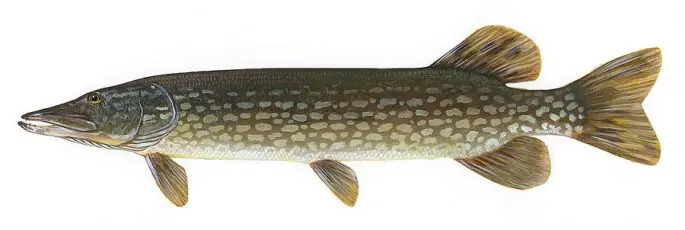
Pike can grow up to one and a half meters in length and weigh about 30 kg, or even more. The fish is characterized by a slanting shape, a relatively large head and mouth. The color of the predator depends on the habitat conditions, or rather the presence of aquatic vegetation. Therefore, its color can vary from gray-greenish to grayish-yellowish or grayish-brown, which is typical for the shade of the dorsal part. On the sides, there may be transverse stripes, as well as large brown or olive spots, of a dark shade. The fins are paired and have a characteristic orange tint. Often, in some lakes there are silver pikes.
Interesting fact! You can distinguish a female from a male using the shape of the urogenital opening: in males, the opening looks like a narrow oblong slit, and in females this opening begins with an oval-shaped deepening outlined by a pinkish border.
Pike can be easily distinguished from many fish species by their strongly elongated head and protruding lower jaw. On the lower jaw there are teeth of different sizes, thanks to which the pike manages to capture and securely hold its prey. The remaining teeth are smaller in size, the sharp ends of which are directed inside the pharynx and go far into the mucous membranes.
Such a structure of the mouth allows prey to pass through the oral cavity without problems, and when trying to escape, the teeth hold it securely and firmly. The characteristic features of the pike are the constant replacement of teeth located on the lower jaw. As a rule, replacement teeth are arranged in rows along the inner surface. These rows of teeth are adjacent to existing teeth, resulting in the formation of so-called “tooth families”.
If the working teeth wear out, then their functions are transferred to the replacement teeth located within the same family. At first, these teeth are not yet strong, but after a while they become stronger and grow permanently to the lower jaw.
Replacement of teeth can be carried out at different times, regardless of the fact that pikes belong to the same family. Much here depends on the conditions of existence in a particular reservoir. As a rule, this process occurs with the advent of a certain season, when the pike begins to hunt too small prey.
5 interesting facts about pike
The nature of the life of a toothy predator

Regardless of the reservoir, pike are attracted to dense thickets of aquatic vegetation. In such areas of the water area, the predator can be immobile for a long time, waiting for potential prey. When a suitable object of food appears in the field of view, the pike makes a quick and sharp jerk. Regardless of how the pike grabbed its prey, it swallows it, starting from the head.
As a rule, experienced spinners know where the pike can be. Therefore, they cast the bait closer to the thickets of aquatic vegetation and spend it on the border of clear water.
Interesting to know! Pike, like other fish, loves to bask in the sun, so you can often see a cluster of large pike near the coastline on the shallows.
Pike, even large ones, often visit small areas of the reservoir. Therefore, very often it is possible to catch quite large pikes in the immediate vicinity of the shore. The predator feels comfortable in conditions when there is enough oxygen. She often does not survive conditions when the level of oxygen drops to around 3.0 mg / liter. Similar conditions are typical for winter, when the water area is covered with ice and oxygen does not enter the water. In addition, algae begin to rot in the water column and at the bottom, which significantly reduces the level of oxygen.
As a rule, the pike is always in hiding, where it is waiting for its prey. Shelters can be both natural and man-made, so it can often be found near bridges or dams. The accumulation of fallen trees and snags in the pond is an ideal place for a predator. If small pike hunts mainly in shallow water, then large pike can be found at depth, but in any case, the pike will look for a suitable hiding place for itself. The pike determines and finds its prey for itself due to the presence of good vision, as well as the low-frequency vibrations that its lateral line picks up.
Lifespan
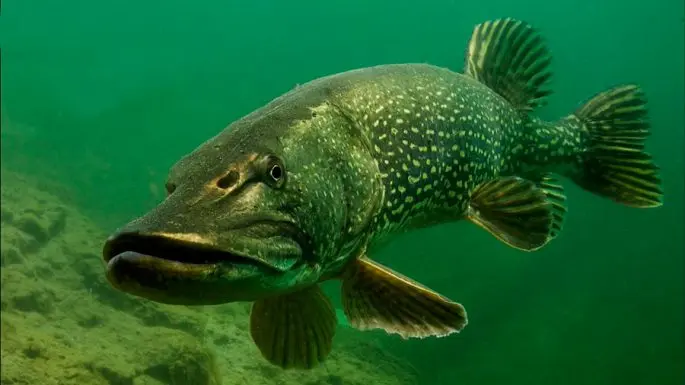
By the vertebrae of a predator, you can determine its age. Many fish species do not have a long life cycle. As for the pike, it can live for more than 25 years, under favorable conditions, and if no one catches it during this time.
Interesting to know! According to one legend, King Frederick of Germany once ringed a young pike that was caught by fishermen after 267 years. During this time, the pike gained weight 140 kg, and its length was 5,7 meters.
Types of pikes with photos and descriptions
There are currently 7 pike species known to represent this genus. Their difference is due to the conditions in which they live, what their appearance is and other features. For example:
Common pike

This is a typical and most common member of this family. This species is found in most fresh water bodies of Eurasia and North America. Her favorite habitats are water areas with thickets of aquatic vegetation located closer to the coastline.
Redfin or American pike
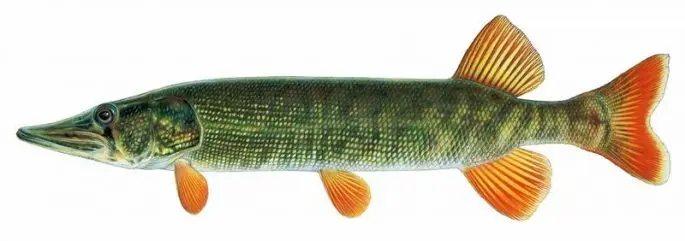
Its habitat is the eastern regions of North America. The variety is represented by two subspecies: the northern red-finned pike and the southern (grass) pike. Representatives of these subspecies do not grow in length more than half a meter and do not gain weight more than 1 kg. This subspecies is distinguished by a somewhat shortened mouth. At the same time, the fins do not have an orange coloring, as is typical for the common pike.
Muskellunge pike

This is the largest, while the rarest representative of this family. The Indians dubbed this predator the “ugly pike”. This predator also has a second name – “giant pike”, which is associated with its huge size. Adult individuals reach a length of 2 meters, while gaining weight up to 35 kg. Depending on the habitat conditions, the predator may differ in a silvery, brown-brown or green tint. On the lateral surface of the pike, there may be either spots or vertical stripes.
Pike striped or black
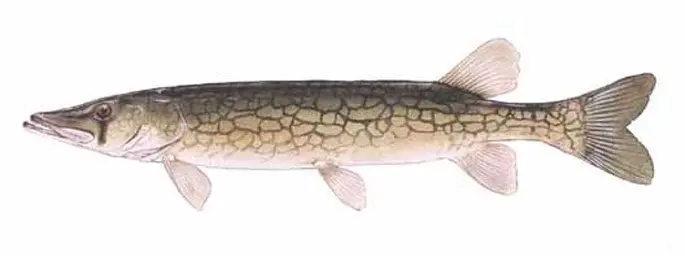
It can grow up to 0,6 meters in length and weigh about 2 kg, although there is evidence that a pike of this species weighing 4 kg was caught. In appearance, the striped pike resembles the northern pike. At the same time, she is characterized by a pattern in the form of a mosaic located on the sides of the predator. In addition, she has a dark, characteristic strip above her eyes.
Amur pike

This type of predator differs in that it has a slightly smaller size compared to the common pike. Individual individuals can grow in length a little more than 1 meter, with a weight of no more than 20 kg. Its feature is small scales that have a silvery or golden-greenish tint. The Amur pike, in terms of the color of the scales, is more reminiscent of the coloring of the taimen, as it has numerous black-brown spots randomly scattered throughout the body, from the head to the tail.
A few years ago, another species was singled out – this is the Italian pike, which was previously considered the common pike.
On the territory of France, only 4 years ago, the type of pike was identified as the pike of Aquitaine. The species is not so well known, as it was described quite recently.
Interesting fact! Hybrid specimens cannot reproduce in natural conditions, therefore, an independent population of these individuals does not exist.
Range, habitats

As mentioned above, the most common species, the common pike, is common in many water bodies of North America and Eurasia. Southern pike or grass pike is found in water bodies included in the Mississippi River basin, as well as in the Atlantic Ocean basin.
Interesting fact! Pike can also be found in desalinated water bodies of the Gulf of Finland, Riga and Kuril, belonging to the Baltic Sea, as well as in the Taganrog Bay of the Sea of uXNUMXbuXNUMXbAzov.
The black pike is a North American predator that is found in rivers and lakes with abundant aquatic vegetation, from the coast of Canada to Florida, as well as the Great Lakes and the Mississippi River Valley.
The Amur pike is common in the natural reservoirs of Sakhalin Island and the Amur River.
The Italian pike prefers to live in the waters of Northern and Central Italy.
Fishing we catch a PIKE monster! Yakutia
Pike diet

Since the pike is a predatory fish, its diet includes fish of various species, such as roach, perch, ruff, bream, silver bream, etc. At the same time, often small representatives of the pike family are found in the stomach of the pike. From spring to autumn, especially large specimens, eat frogs and molting crayfish.
There are cases when this predator pulled under the water not large birds, rats and mice, squirrels and sandpipers, which for various reasons ended up in the water. Given that the pike can reach sizes over a meter, then there is a possibility that this predator can also hunt adult ducks, especially during periods when the bird is molting and cannot take to the air in a timely manner. In addition, the trophy pike is capable of attacking fish that are more than 50% the size of the predator itself.
According to experts, low-value, and numerous species of fish predominate in the diet of pike. In this regard, the pike is not capable of causing significant harm to fisheries. If the pike, as a predator, disappears from the reservoir, then this first of all indicates that an uncontrolled increase in the number of other species of predatory fish, such as perch and ruff, has begun. These predators, which are not large compared to pike, can actively eat the eggs of other fish species, which causes significant damage to the population of various fish species, including pike.
Breeding process

In the natural environment, females are ready to lay eggs in the fourth year of life, and males are ready for fertilization – in the fifth year of life. When the water temperature rises to +5 degrees, this is a signal that the pike should go to spawn. This usually happens when the ice melts. In other words, pike spawns before other fish species. When fry of other fish are born, the “feelers” have already grown to such an extent that they can feed on them. Thanks to this feature, there are never any problems with food for small pike.
The predator spawns within the coastline at a depth of 0,5 to 1 meter. During the spawning period, the pike goes to shallow water and spawns rather noisily. First of all, small individuals spawn, and in the end – trophy specimens. The spawning period falls on the spill, when the rivers overflow their banks. At the same time, meadows are flooded, and the water in these areas warms up quickly. Basically, pike goes to such areas, realizing that here the eggs will ripen much faster.
The female goes to spawn surrounded by 3 or 5 males that follow her, but at the same time they are half the body behind the female. When moving, the males cling to the female, both from the sides and from the back, so during this period you can see how the upper body of the fish looks out of the water, along with the fins.
When the female spawns, she rubs against the roots, bushes and stems of aquatic vegetation, as well as other objects. At the end of the spawning process, females can jump high out of the water.
Interesting fact! Depending on weather conditions, fry from eggs appear after 1 or 2 weeks. At first, pike fry feed on small crustaceans, after some time the “feelers” begin to feed on fry of other fish.
Depending on the size of the predator, the female can lay from 17 to 200 thousand eggs, about 3 mm in size. The eggs are slightly sticky and after a couple of days they cannot be held on objects. Because of this, their further development occurs at the bottom of the reservoir. If the water level drops rapidly, then this leads to mass death of eggs. This is especially true in reservoirs, in which the water level is unstable, which is artificially regulated.
Natural enemies of pike
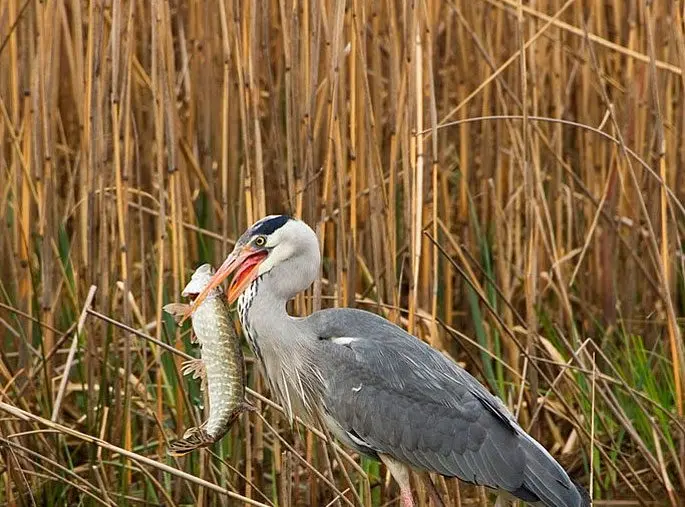
Given the fact that this predator can grow to an impressive size, it is hard to even imagine that the pike has natural enemies. Pike are often preyed upon by otters and bald eagles. In Siberia, large individuals are also quite rare, as the taimen can easily cope with pike of any size.
In the southern regions, pike suffers from such a predator as catfish. If the pike is still small, then it is hunted by perch and rotan, as well as large pike perch. In addition to natural enemies, the pike also has a more formidable enemy – this is a person in the guise of an amateur fisherman. Catching a trophy pike is the ultimate dream of any spinner. We can safely say that pike hunting, especially recently, has become quite widespread, which can significantly affect the populations of this predator.
Population and species status

Pike in many water bodies is considered the most massive representative of the ichthyofauna, so it does not yet act as an object for special research, although if everything goes at such a fast pace, then in the near future the pike will also have a hard time. More recently, there were a sufficient number of trophy pike in the reservoirs, which ate their relatives, thereby regulating the number of predators at the natural level. When a person intervenes in this process, then you have to wait for trouble.
It is important to know! In any reservoir, predatory fish acts as a biological regulator of the abundance of many fish species, as well as a valuable species of commercial interest.
Somewhere in the 50s of the last century, active catching of trophy pike began, which significantly changed the general structure of the abundance of this predator. As a rule, pike now manage to spawn at a young age. In this regard, the number of small pike increases and the percentage of medium-sized individuals decreases. And, nevertheless, today the pike has the conservation status of “Species that does not cause concern.”
Commercial value
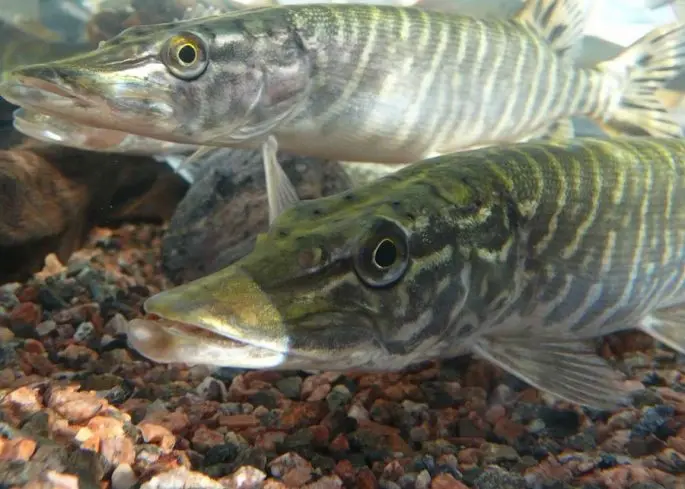
Pike is actively grown in artificial conditions, as it is considered the most useful dietary product. Pike meat contains a large amount of protein and only 1-3 percent fat, not counting other useful components that are easily absorbed by the human body. This is typical for any seafood, so fish must be present in the human diet. Thanks to fish, a person manages to maintain the level of nutrients that directly affect human health. Therefore, pike is a fairly popular commercial fish. In addition, the predator is actively grown in pond nurseries and is an object of both amateur and sport fishing.
Pike are caught quite actively these days by amateur fishermen, using the most modern fishing gear for this. This has become possible thanks to the achievements of modern industry, which produces unique artificial baits for pike, as well as reliable and durable rods, including other rigging elements. Fishing is so active that it is possible that the status of pike may soon change to “Species that may disappear”, at least for some regions. Pike can only stay in hard-to-reach places where a person cannot reach without special transport.
Recently, the number of fans of spinning fishing for predatory fish has grown and, oddly enough, everyone is aiming to catch a pike. And this is due to the fact that the number of people with personal transport has increased. Sometimes going fishing is more expensive than buying fish in a store, but this does not stop people, because fishing is quite an exciting activity. Everyone wants to spend the weekend for the benefit of themselves, recharged with energy. This is typical of our time, since everyday fuss takes away a lot of strength, both physical and psychological.
Some fishing enthusiasts prefer paid reservoirs, since the catch is guaranteed here. This is a good sign, since fish farming is practiced in such reservoirs, and the catch is controlled.
All about pike! Answers from an ichthyologist.









